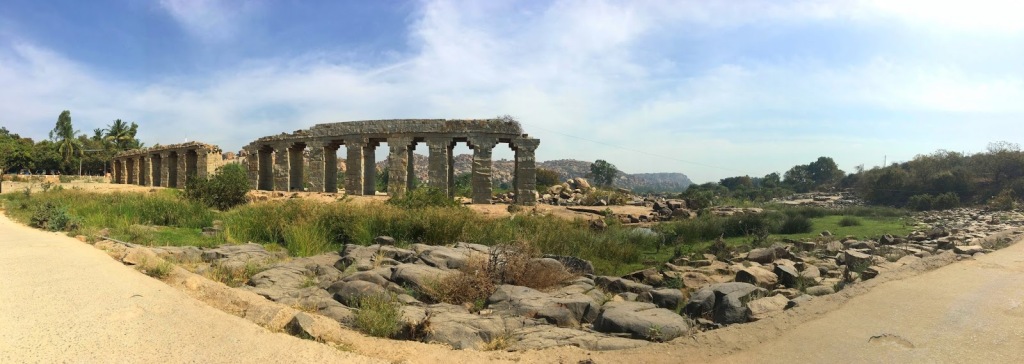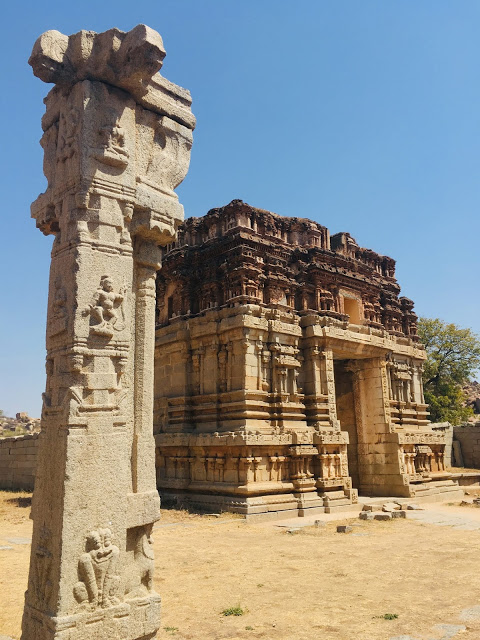Hampi, with all its temples, palaces and fortresses in balletic ruins, exemplifies the rich cultural, architectural, cosmopolitan, and historical legacy of the Vijayanagara Empire, which once thrived on these very banks of the Tungabhadra river.
Most of the people do not associate the ancient ruins of Hampi, detritus of the civilisation along the banks of the Tungabhadra river, with the same reverence and grandeur as the ruins along the Indus or other timeworn vestiges. Hampi was the former capital of the Karnataka Empire, established around 1336 A.D, having collapsed some time in the seventeenth century, and has a rich history representing the formulation, glory and finally, the demise of the Vijayanagara Empire.
It is a place that, in its own way, has a presence – a personality, a charisma, as one might say, put together in form of rubble, remnants and records!

Just ten kilometre from the town of Hospet, which is well connected by rail and road ways, Hampi is easily accessible from most parts of the country. The town is split into two contrasting sides by the Tungabhadra river. The South side of the river narrates the tales of relics of the ancient times, the place stationing family vacationers (mostly); whereas the other side – The Hippie Island, or the Northern side – is the place constantly buzzing with ample music cafes and joints, the reason why Hampi is notorious among the modern day backpackers. However, each side has its own unique appeal and is a gateway to the winsome temples that stand under the smouldering sun.
A majority of Hampi, though, lies on the south bank of the river. This is where cows roam on pathways, kids play on road-sides while their family sells fruit or makes shoes, and local jewellers promote their goods. Every morning and evening is a surreal show of the day-to-day life when villagers fill the streets, making their way for prayer to and from Virupaksha temple, where Lakshmi, the temple deity, resides. The North side, on the other hand, set amongst the rice paddies, gleams in vivid earthy colours.

In Hampi, each temple has unique history and requires its own mini adventure. Some temples are greater in size, and more historically and mythologically recognised than others, but under no circumstances, should you disregard the smaller and less outwardly decorated ones! These are the ones that are the most quiet, peaceful ones. The temples that I took time to explore, and perhaps are my favourite, even to this date, are the Hanuman temple, the Achyutaraya temple and the Virupaksha temple.
Achyutaraya temple
The Achyutaraya temple is one such place where the traveler can sit in serenity, breath, take it all in, and soak oneself with the solitude, the nonchalance of the rubble.

Built somewhere in 1500s, this is perhaps one of the most splendid, raw and awe-inspiring places in all of Hampi, hosting the deity ‘Lord Tiruvengalanatha’, which is another form of Lord Vishnu. However, in the later times of the Vijayanagara empire, it came to be called after the king in whose reign it was built. Hence, it became widely known as the ‘Achyuta Raya’ temple. Mostly less crowded for better part of the day, thanks to all crowd being pulled towards the Virupaksha temple, this is one such place where the wayfarer can sit in serenity, breath, take it all in, and soak oneself with the solitude, the nonchalance of the rubble, and the sight of magnificent ruins, situated alongside the Matanga Hill.

Matanga Hill
About 10 minutes of a moderate trek from the town centre takes you to the Achyutaraya temple (a part of the reason why many family vacationers and tourists avoid this temple due to lack of direct road connectivity, and hence, a favourite place among many backpackers!). At the end of the mini-trek, a left exit leads to the Achyutaraya temple and the right one leads to Matanga Hill, a hummock that is responsible for scintillating views of Hampi, especially during the sunset! The ascent to the top takes about thirty minutes, total step count is around 600 and trust me, it’s a rather surreal climb with some fantastic views. On the way up as you near the peak, there is a cave formed between two ginormous boulders. Passing through this cave eventually leads you to the shrine atop this hillock.
It’s a beautiful sight up at from hill, indeed one of the best places to see Hampi. As you explore this hill , there is alays something of interest pretty much everywhere you look. At one corner, one can see the Turthu Canal serenely making its way through banana plantations. While on the other end, there’s the Tungabhadra River that flows through the town. In the distance, the Virupaksha Temple looms. And you can also look down to see the Achyutaraya temple complex as well as abandoned bazaars and Hampi’s rock-studded landscape.

Virupaksha temple
Despite the innumerable renovations done in recent times, the Virupaksha temple retains its raw beauty, still encompasses an aura of dexterity and the archaic architecture.
This temple is perhaps the oldest and the most known symbol of Hampi. Situated on the embankment of River Tungabhadra, this is the predominant centre of pilgrimage in Hampi, the holiest and the most sacred retreat of all. This temple has survived through the centuries and never ceases to prosper, still being a pristine spot amidst the ruins that surround it. One is greeted by hoards of pilgrims from the moment one steps inside this temple. Despite the innumerable renovations done in recent times, this temple still retains its raw beauty, still encompasses an aura of dexterity and the archaic architecture. This temple is visible from most of the high points in Hampi, and is just a couple hundred metres from the town centre.

It is the fact that rubble, rice fields, plains and hills all dwell in a single burg, is what makes Hampi the place it is!
The Town of Hampi
Set among the vast plains of south India, looking in one direction makes you feel like you are in the jungle, while turning your head in the other makes you feel like you are in the desert! It’s not only the temples which took my breath away, or the colours of the sunsets that slowly disintegrate like a shimmer of gold dust, but the uniqueness and raw authenticity of this sacred town. The Shiva Temple, located on Anjanadri Hill, the Hanuman temple, which lies just before the Achuytaraya temple, the Shrikrishna temple, which lies a couple hundred metre from the town centre, all make Hampi a place where history, mythology, spirituality and theology come together!
While the Shiva temple made waking up at dawn for watching the sunrise an absolute delight, the day ended on equally glorious terms by watching the sunset from Matanga Hill. While the Achuytaraya temple is a place for the claimants of peace and seclusion, the Virupaksha temple, the Shiva temple are places meant for the ardent backpacker! The Vitthala temple, on the other hand, is a known UNESCO heritage site, which depicts the stone sculpture commonly found on Indian currency notes, that is misconceived by many as a chariot (which actually is a shrine of Lord Vishnu’s vehicle, the Garuda).

The ruins found here may not be as special as elsewhere; it’s the setting, the ambience, the fact that temples dedicated to Shiva, Hanuman, Vishnu and Ganesh all reside in a single borough, that makes them so magnificent. It is the fact that rubble, rice fields, plains and hills all dwell in a single burg, is what makes Hampi the place it is!

Leave a comment